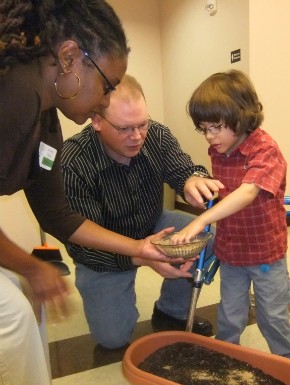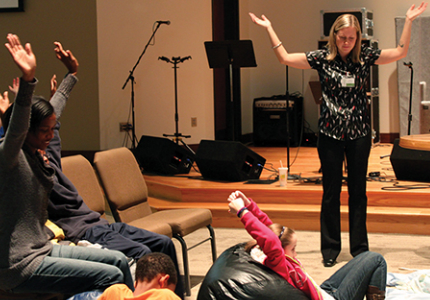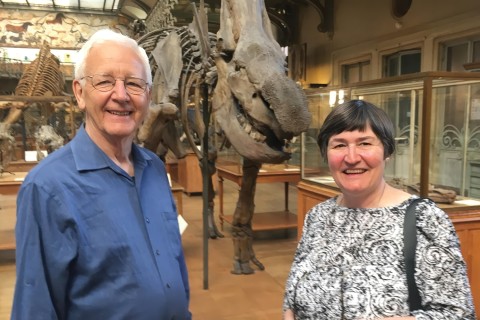Joyful noises: A worship service with children of all abilities

It’s Saturday morning, just before ten. My daughter Harper and I are a little early for the service, so we stop at the church playground for a couple of trips down the slide before we head inside. Just outside the door is a large piece of plywood, propped up and painted to look like a jigsaw puzzle. There’s a hole in the middle where one of the puzzle pieces should be. Harper knows what to do immediately: she scampers behind the sign and pokes her head through the hole. I oblige and take a picture, her grin complementing the painted words: “You belong here.”
The “here” where we belong this morning is a sensory worship experience offered by Salvage Garden, a nonprofit organization in Greensboro, North Carolina, that’s hard to categorize. Part church, part support network for families and individuals with special needs, Salvage Garden strives to create a space where all are welcome, regardless of age or ability. The Banquet—the worship service we’re heading into now—is Salvage Garden’s primary activity.
Salvage Garden founder and executive director Melissa Guthrie sees us and comes to say hello. Melissa and I know each other well; when she’s not running Salvage Garden and leading worship at the Banquet, she works as the communications manager at the church where I serve.
“The musicians just got here!” she tells me, nodding toward the guitar player and vocalist warming up. She’d told me earlier that her regular music leader wasn’t available today so she was expecting someone new. She handles the hiccup gracefully, embodying the nonanxious presence of a good pastor, and goes to greet another family.
Harper and I settle into our seats—she in a beanbag chair on the floor in front of me—and wait for the service to begin. She is fiddling with a toy she picked up on the way in; a table by the door holds a variety of toys to keep active hands occupied during the service. One family arrives with a boy in a wheelchair. Two men sit down next to us—a father and son, I learn later; the father greets us, but the son doesn’t respond when I try to say hello. Some kids claim beanbag chairs like Harper’s; others sit close to their parents or wander at the edge of the worship space. One couple with no kids in tow sits quietly in the back row. Later, when we pass the peace, I realize that one of them is blind.
In some ways, the Banquet feels similar to any other worship service: there’s gathering music, a scripture reading, a message, time for prayers, a sending forth. But an intentional effort is made to include all ability levels. Each service’s theme is different, but the order of service stays the same, providing a reassuring handle for worshipers who get anxious in new settings. The printed order of service is laminated, and it includes pictures for nonreaders. Some participants have short attention spans, so each part of the service moves quickly to the next.
 |
| PHYSICAL SIGNS: Melissa Guthrie leads the community in a prayer that engages the whole body. |
The service includes spoken words, but there is also plenty of movement. The prayer—like the order, the same every time—involves standing up and doing arm and hand motions to accompany the words. Nonchoreographed movement is encouraged and expected, too. Often someone will get up from their seat and wander. One particularly active boy slips out of reach of his caregiver, who chases him down with the help of another worshiper. The woman reading the scripture passage is as unfazed by the action as she is by a sudden shriek from one of the participants.
Multisensory engagement is intentional as well. Each service includes “breaking bread,” which engages the sense of taste. (This is not presented as communion; one of the open questions at Salvage Garden is whether and how, given the commitment to inclusivity, to include people from other faith traditions.) Smell and touch are included with a blessing of oil offered by the worship leaders on the back of each participant’s hand. I watch as the boy in the wheelchair across from us wordlessly accepts the blessing. It is, indeed, a banquet—a feast for the senses and the soul.
The story of Salvage Garden is inseparable from Melissa’s own story—her call to ministry and her call to parent Tommy and Stephanie. Tommy and Stephanie came into Melissa’s life as foster children who had been terribly neglected. When they met—with only a few hours’ notice from the county social workers—Stephanie, then six, told her two-year-old brother, “Tommy, this is Ms. Melissa. She looks nice, and she’s going to take care of us.”
Six years later, “Ms. Melissa” is simply “Mom” to Stephanie, often uttered in a middle schooler’s classic whine. Tommy, who is mostly nonverbal, calls her “Mama-Issa” and uses his arms in a dramatic movement taught by his teachers and speech therapists to force the sound out of his body. Though the social workers were aware that he had some developmental delays when he was placed with Melissa, it wasn’t until he was four that he had an official diagnosis: autism.
Tommy is eight now, with the cognitive abilities of a young preschooler. He communicates via a combination of sign language and speech. He’s happiest in familiar settings, with familiar people. New places are overstimulating and make him anxious. He loves to play outside, digging in the dirt or raking leaves. He loves music and, Melissa says with a smile, “he’s not a bad dancer, either.” Melissa has installed hammocks inside and outside her house, as he loves to swing—on anything—as high as he can. His constant movement earned him the nickname Tommy the Tornado from a summer camp counselor a few years ago. His blond hair is strikingly similar to his mom’s; new acquaintances are often surprised to learn he is adopted.
According to the Centers for Disease Control and Prevention, autism spectrum disorder now affects one in 88 Americans. Among other things, individuals with ASD often have atypical responses to sensory input. Tommy loves the feel of the wind on his face while he swings, and he likes to wear clothes with a variety of interesting textures. But as Melissa is quick to point out, autism affects everyone differently. “If you’ve met one person with autism,” she reminds me, “you’ve met one person with autism.”
At the same time Melissa was welcoming Tommy and Stephanie into her family and getting a crash course in parenting a child with autism, she was beginning classes in the M.Div. program at Wake Forest Divinity School. Getting to know these children—and especially discovering Tommy’s special needs—shaped her calling and her studies. She started reading about the theology of disability, and she began wondering how she would share her faith—a tradition so grounded in word and story—with a child who will likely never read or speak.
She also began taking Tommy and Stephanie to church.
Going to church, however, was easier said than done. Melissa found that many traditional churches are ill-equipped to welcome people with needs like Tommy’s, especially at worship. Stillness and quiet are virtues at many worship services, and there is very little physical movement—a nightmare for someone like Tommy, whose constant movements keep him centered. Most worshipers spend the service sitting in one position, standing only occasionally for a hymn or two. Bowed heads and folded hands are often the only physical signs of prayer.
Even the liturgy itself can be an impediment to someone with different abilities. We are people of the word, we like to proclaim. We offer a word of prayer, we recite the words of institution, we read the words of the ancient scripture. But what does this mean to someone for whom words themselves are an incomprehensible language?
Church staff and volunteers are unprepared, too. Most Sunday school teachers, children’s church leaders, and nursery attendants aren’t trained to care for children who have autism or other special needs. The point isn’t that these leaders are to blame, just that this is the reality of the situation. And sometimes this reality is the difference between finding welcome and being left out.
Melissa remembers wrestling with Tommy in the back row of the sanctuary during one church visit, trying to keep him from disrupting the other worshipers. She remembers all too well the moment when another parishioner approached and suggested that they should leave. Another parent of a child with autism—a regular at the Banquet—remembers how difficult it was to take his son to church. “They just weren’t ready for us. It wasn’t fair to us or them.”
“He just doesn’t belong in a church nursery,” another mother, Angie, says of her son David. He was born at 24 weeks and faces a long list of special needs, epilepsy and autism among them. He spends his days in a wheelchair cart that carries all his equipment. She’s right; it’s hard to imagine him even fitting into my church’s small nursery room.
One story Melissa carries with her is that of a family whose child required supplemental oxygen 24 hours a day. To go out, anywhere, they had to transfer him to a portable oxygen tank, which could be carried to and from. One morning at church, as the hum and pulse of the oxygen machine could be heard during the quiet parts of the service, a woman sitting in front of them turned and said, “Could you turn that off?”
It may just be, of course, that the woman didn’t realize what was making the noise. One hopes that had she known that the pulsing machine was pumping air vital for the child’s very breath, she would have been more gracious. But to the mother of the boy who needed the oxygen to stay alive, the comment was the opposite of hospitable: her son, and her son’s needs, were not wanted there.
Stories like these—along with a vision of the kingdom of God where all are embraced, accepted, and loved—planted the seeds that became Salvage Garden.
When Melissa tells the organization’s story, she says “we,” but she really means “I.” She has an advisory board of volunteers, and she’s had good help from colleagues and friends. These include divinity school classmates Cindy Good and Brian Russell, who dreamed with her in the initial planning stages and helped get Salvage Garden off the ground. But this has been Melissa’s vision, and—as with most small nonprofits—most of the work falls to her.
A grant from the North Carolina Synod of the Evangelical Lutheran Church in America supported Salvage Garden in its first year, enabling the Banquet to move from a monthly to a twice-a-month schedule. But now—as the Banquet approaches its second anniversary—donations and gifts provide funding for musicians, space, and supplies, and the budget is tight.
Worship attendance, however, is growing. Salvage Garden is meeting a need.
At the service I attended with my daughter, the “drama” centered on modeling clay—the edible, homemade kind. “You are part of the mix,” Melissa reminds the children gathered at the front of the worship space. She hands them each a blob of dough and invites them to mix in gummy bears. This is sensory worship at its best: participatory, involving taste and smell and touch, with a variety of textures for curious hands.
The drama feels like the children’s moment at my congregation, in which my daughter regularly participates. Yet here she declines to go forward to join the other kids, and she ignores my nudges to go up to get some dough when it’s offered. But when a volunteer approaches with gummy worms—the idea was to mix them into the dough—Harper’s eyes light up. “Want some?” the volunteer asks, and she nods, popping them into her mouth as soon as they hit her palm. It’s a moment of hospitality that embodies what Salvage Garden strives for: you can participate as much, or as little, as you want or are able.
Eight-year-old Jack is munching a snack while I visit with his father, Scott, after the service. He sits with us for a few minutes and then wanders away to where his sister Emily is playing; his dad keeps one eye on him while we talk. Scott tells me that Jack is “on the spectrum”—the autism spectrum—and Emily is “typical.” (I keep noticing how intentionally these parents choose their words. Melissa herself stresses the importance of “person-first language”—Tommy is her “son who has autism,” not her “autistic son.”) Scott and his family were new to town when they met Melissa at an activity of the local Autism Society, and they’ve been regulars at the Banquet since it began. They’d tried visiting another congregation, looking for a church home, but Jack couldn’t stay quiet in the service; they were self-conscious and reluctant to try again.
Scott likes the openness and inclusivity of the Salvage Garden organization. “It’s the first church we’ve found that lines up with what we think,” he says. And it’s not just the welcome they’ve received at Salvage Garden that has become so important to them. It’s also the opportunity to welcome others. “We give so much to Jack and Emily,” Scott says, that it’s good to be part of a community where they can offer that same hospitality and care to other families.
Large group activities are hard for Jack; the unpredictability of social interactions makes him uneasy. Like many people living with autism, he prefers a familiar setting and a familiar routine. The Banquet’s consistent liturgy provides that for him. He follows along on the printed order of service.
Scott explains that one of the effects of Jack’s autism is that “he doesn’t know where his body is.” Sitting still doesn’t work so well; wandering does. The Banquet is held in a local church’s contemporary worship space—a large room with movable chairs and lots of space in which to move around. “A pew in a church just doesn’t work,” his dad tells me. This does. Jack loves the loud music and the tactile, experiential parts of the service. He gets to participate and engage in the service, rather than simply trying—and likely failing—to keep quiet.
Jack’s sister Emily loves the service, too. She is the social one in the family. While Jack wanders the perimeter of the room during the fellowship time after the service, Emily flits from table to table to chat with friends. It’s good for her to know others who have siblings who are like Jack. It’s good for her to be welcomed, too.
In my own fairly traditional congregation, we like to think of ourselves as a welcoming, friendly, hospitable place. The reality is that we really aren’t prepared to welcome Tommy on Sunday morning. Our straight rows of pews would feel so confining to his active little body. Our service involves lots of sitting still and very little to smell, touch, or taste—baptism and weekly communion notwithstanding—and our nursery staff, while loving and wonderful caregivers, simply don’t have the necessary training to include Tommy or keep him safe.
One Sunday evening, Melissa brings Tommy to our fall festival. It’s just before Halloween, so most of the kids are in costume. Tommy is dressed up, too, in a pinstripe suit and fancy dress shoes—not so much a character costume as an expression of his love for texture and clothing. “He wants you to notice his shoulder pads,” Melissa translates over and over again to church members who come over to say hello. Some of us have met Tommy before, when Melissa has brought him to the office on a weekday or met his caregiver to swap car seats in the parking lot. But this is the first time he’s come to an all-church event. It is overwhelming for both of them.
The day of the festival, Melissa texts me, wondering if it’s OK to bring him, worrying about what will happen if he has a tantrum. “Please come,” I write back. “They will love him no matter what.” And I know this is true—that the people at my church will love Tommy—but I also suspect that we don’t really know how to love him.
My suspicion is correct. Everyone is kind to Tommy; everyone admires his fancy outfit. But it’s clear that none of us quite knows what to do next. Melissa keeps her hand on his shoulder the whole time, and she confesses later that she’s afraid of how church members will react if he acts out or runs away. I notice that no one offers to sit with them, and they don’t sit long anyway. He is more inclined to wander, so the two of them take a walk around the church. They end up playing alone on the playground outside while the party goes on downstairs.
Melissa tells me that one of the things she’s learned—one of the concepts on which Salvage Garden is built—is that when it comes to adaptations aimed at welcoming people with disabilities, changes to a church’s physical space are the easiest changes to make. It’s one thing to build a ramp up to the building or to remove a pew to make room for a wheelchair. It’s quite another to make worship accessible for people who can’t read the hymnal, can’t hear the music or the words being spoken, can’t control their bodies or the noises they make.
Melissa says she has to remind herself that most churches don’t have the knowledge or the resources to be truly welcoming to people of all abilities, but that there should at least be a spirit of hospitality. I wonder if my congregation has passed the test.
Toward the end of the Banquet service, it is time for “Joyful Noise,” during which everyone plays an instrument—those kid-friendly instruments you played in elementary music class, the shakers and sticks and triangles.
“Are there enough?” I ask the volunteer passing out the instruments, glancing around the room. I don’t want to take one if there is a kid who wants to play. She assures me there are, so I grab a maraca and shake away. The professional musicians up front play as well, but “noise” is an accurate description. Midway through the song, Harper wants to switch instruments with me. I am enjoying watching her enjoy the music, and I imagine that the other parents in the room feel the same as they watch their children participating in whatever ways they can.
Up near the high ceiling of the worship space sit several small windows. These remain covered with blinds for most of the service, darkening the room so the projected pictures and words can be seen. As worship ends, the congregation sings “This Little Light of Mine”—and the shades open. They’re operated by remote control, but the effect suggests that our singing has raised the curtains and let the sun shine in. Angie tells me it’s her son David’s favorite part of the service. It is Harper’s, too. “Look, Mom!” She pokes me and points. “Light!”
As Salvage Garden grows, Melissa hopes to offer support services, like a faith-based support group for parents and caregivers of kids with special needs. Melissa says she herself participates in a number of groups, but none in which she can really wrestle with the tough questions of faith or the tough stories in the Bible. To a parent of a child who will never be “healed” of his illness, the stories of Jesus healing the blind man or the hemorrhaging woman are heartrending. They lead to bigger questions about what wholeness really looks like.
Salvage Garden could also one day offer Christian education opportunities for people with disabilities, embracing multisensory learning methods to teach Bible stories and faith traditions. Or maybe the organization will become a resource center for churches—such as mine, perhaps—where people want to learn how to integrate all our senses, our whole selves, into our practices of worship, learning, and service.
Just as Melissa doesn’t call Tommy her “autistic son” because she doesn’t want him to be defined by his disability, she also does not want Salvage Garden to be defined by its accessibility to people with disabilities. She doesn’t want it to become a “special-needs church.” In church-first language, then, this is a church where everyone can participate. David in his wheelchair, Jack on the spectrum, and my typical daughter, all making a joyful noise together. The goal is not simply a worship service where people with developmental disabilities are welcome. It’s a service where all are welcome.
“Jesus’ message,” Melissa says, “is that there is a place for everyone: gay, straight, black, white, special needs, homeless.” She knows it’s a tall order. “That’s the kingdom of God; we’ll be working on that forever.”
Read the sidebar article on welcoming children with disabilities.



